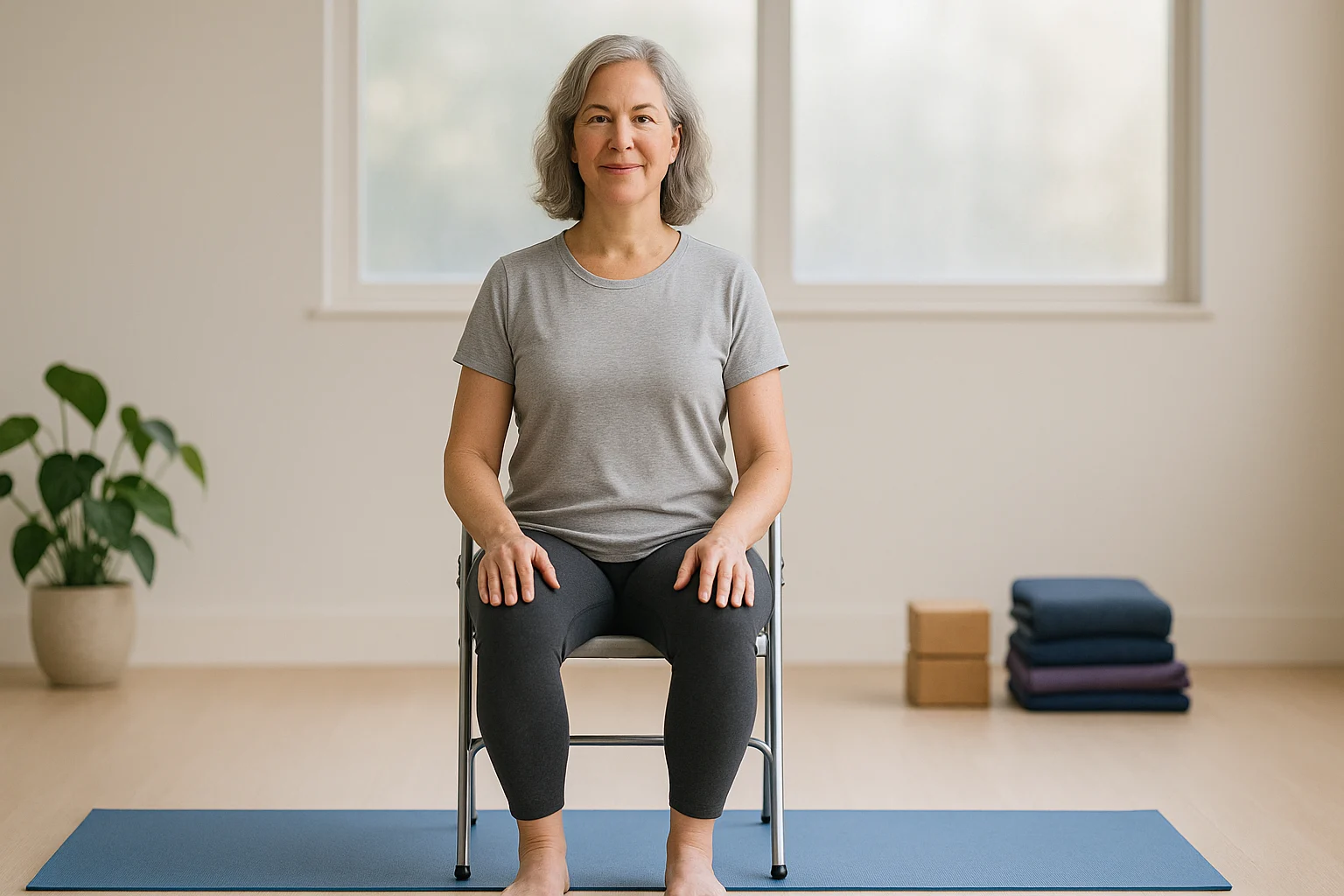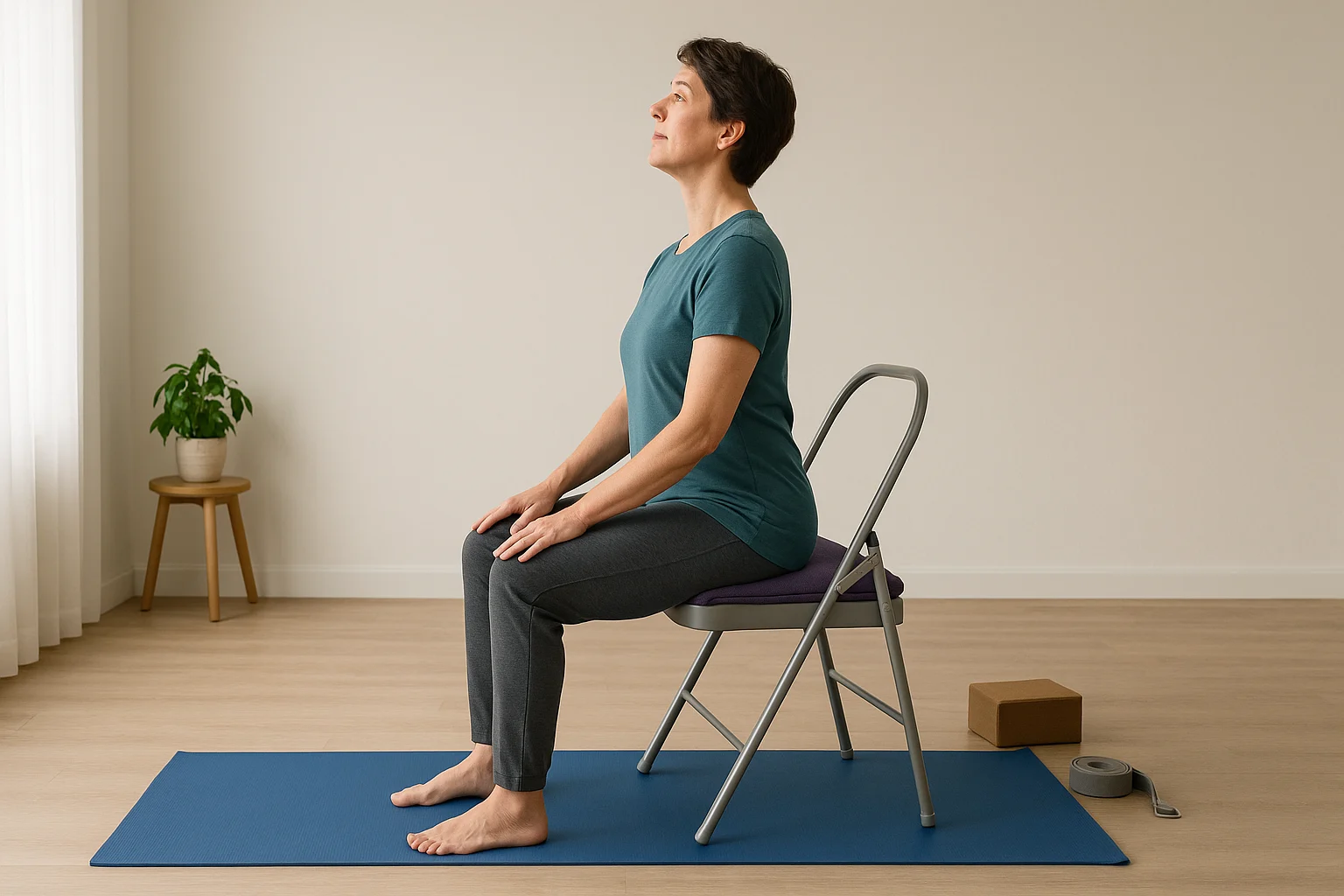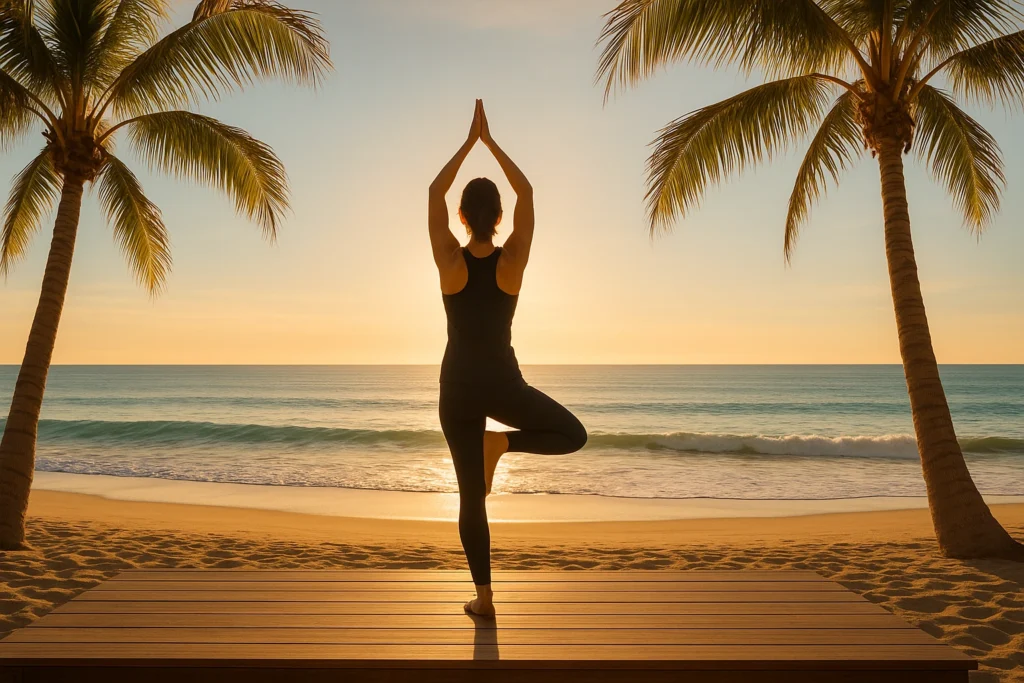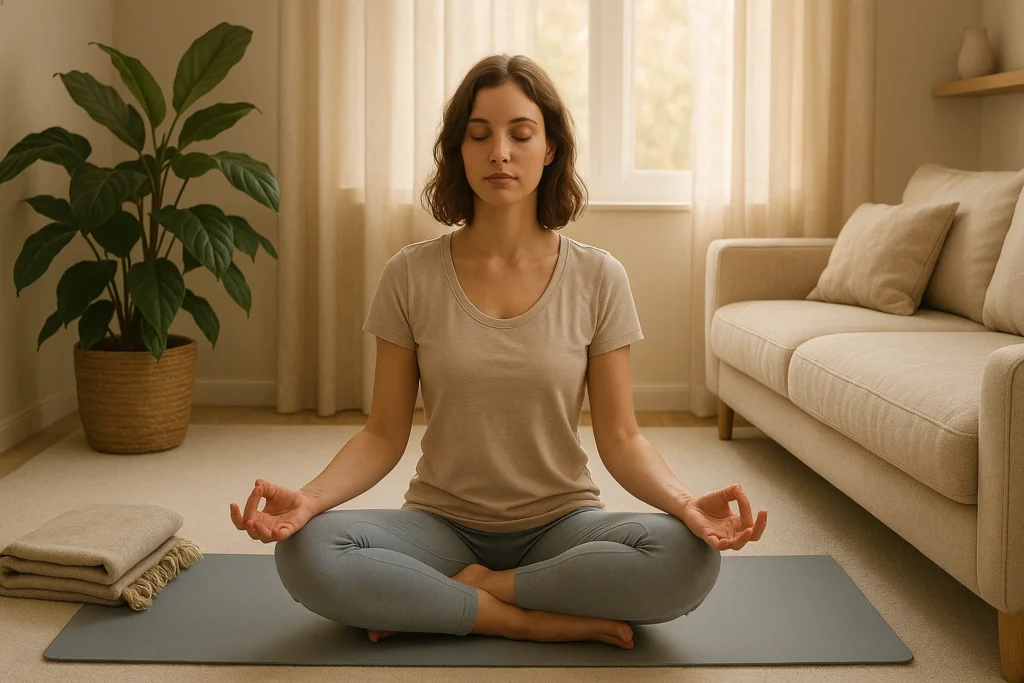
Tired of MS fatigue holding you back? Yoga multiple sclerosis basics can start in just 10 minutes and may help ease fatigue and support balance. This gentle, adaptable practice connects mind, body, and breath—at your pace. Explore safe poses, benefits, and how to begin in our yoga specialized health guide.
Yoga Multiple Sclerosis: Understanding Movement
MS affects your brain and spinal cord. When the immune system attacks the myelin—the insulation around nerves—signals don’t travel as well. That’s why symptoms can be varied and unpredictable.
Common MS Symptoms
- Fatigue: Deep tiredness that can linger, even after resting.
- Numbness or tingling: Pins-and-needles or numbness in the face, arms, or legs.
- Walking difficulties: Balance or coordination changes that can make walking harder.
- Muscle weakness or spasticity: Muscles that feel weak, tight, or stiff.
- Vision problems: Blurry or double vision.
- Pain: Pain or muscle spasms.
- Cognitive changes: Trouble with memory, focus, or processing speed.
Movement is key to managing MS. Regular activity strengthens muscles and reduces stiffness. For example, adaptive yoga offers a gentle, effective way to move.
In short: MS disrupts nerve communication, but mindful movement like yoga supports mobility and comfort.
Yoga Multiple Sclerosis: 5 Benefits
Think of yoga as a gentle reset for your nervous system. By syncing breath, body, and attention, it can ease common MS symptoms—especially fatigue. In the context of yoga for neurological health, the National MS Society also highlights yoga as a supportive option.
Better Balance and Stability
MS can throw off balance and raise the risk of falls. Yoga builds core strength and body awareness. Using a chair keeps things steady and low-risk.
“Yoga made me feel grounded. I’m less afraid of falling now.” — adaptive yoga student
Enhanced Strength and Flexibility
Stiff or weak muscles? Gentle stretches build strength without overdoing it. They also open the joints, making everyday tasks—like dressing—easier. Explore more in our yoga flexibility guide.
Reduced Spasticity and Pain
Spasticity tightens muscles. Gentle yoga stretches relax them, while breathing calms spasms. This may help reduce chronic pain for some people.
Improved Energy and Fatigue Management
Yoga may help manage MS fatigue. Restorative poses and mindful breathing may improve sleep and energy. Many people report feeling more refreshed.
This post has affiliate links. We may earn a commission. Learn more.
Get a Simple Sleep–Stress Baseline
When fatigue and stress feel unpredictable, a quick at-home check can help you tailor your routine. This kit delivers lab results in days and pairs well with gentle yoga and better sleep habits.
Choose your kit Partnered
Use code Max15 for 15% off sitewide.
Not medical advice; consult a healthcare professional for personal guidance.
Boosted Mental Well-being
MS can be emotionally taxing. Yoga’s mindfulness and breathing may help reduce anxiety and ease low mood. It’s a mental reset for tough days. Try our mindfulness techniques for stress for added calm.
| Benefit Area | How Yoga Helps |
|---|---|
| Balance | Strengthens core, improves body awareness. |
| Strength | Builds muscle tone without strain. |
| Flexibility | Eases stiffness, improves joint range. |
| Spasticity & Pain | Stretches relax muscles; breathing reduces spasms. |
| Fatigue | Improves sleep, regulates energy. |
| Mental Well-being | Reduces stress, promotes emotional resilience. |
In short: Yoga for MS enhances physical and mental health, making daily life easier.

Safety Tips for Yoga with MS
Yoga can help—go gently and listen to your body. Your body may feel different day to day. Here’s a safe way to start.
Consult Your Doctor
Before you start, check in with your neurologist. They can confirm whether yoga fits your situation.
Stay Cool
Heat can make MS symptoms flare. Practice in a cool room, skip hot yoga, and drink water often.
Use Props
Chairs, walls, and blocks keep poses within reach. Treat them as comfort tools, not crutches. Learn more about essential yoga props.
Pace Yourself
Start with 10 minutes. Add time only when you feel steady so you don’t crash later.
Honor Your Body
If you feel pain or dizziness, pause and rest. Yoga is about ease, not pushing through.
In short: Safe yoga means consulting doctors, using props, and respecting your body’s signals.
Best Yoga Types for MS
Fast classes can be too much with MS. The styles below keep things gentle and supportive.
Chair Yoga for MS
If mobility is limited, chair yoga offers seated or supported poses. It also reduces balance worries.
Restorative Yoga
With plenty of props—blankets and bolsters—this style invites deep rest. It’s great for fatigue and stress.
Gentle Hatha Yoga
Hatha moves slowly with attention to breath and alignment. Look for teachers who adapt for MS.
Adaptive Yoga
Yoga with adaptations is built for chronic conditions—every pose can be modified. Instructors tailor the practice to your MS symptoms; many people think of this as therapeutic yoga for MS in action.
In short: Chair, restorative, and adaptive yoga are often safe, effective choices for many people with MS.
Yoga Multiple Sclerosis: Gentle Poses
Which MS symptom shows up most for you? These accessible MS yoga poses target stiffness, balance, and fatigue—and work even better with props.
Seated Cat-Cow
Sit in a chair, feet flat. Inhale and lift the chest (Cow). Exhale and round the spine (Cat). Benefits: Loosens the spine and wakes up the core.
Seated or Reclined Leg Lifts
Seated: Extend one leg, pause, then lower. Reclined: Use a strap to lift with support. Benefits: Helps build leg strength and gets blood moving.
Gentle Seated Twists
Sit tall, then twist gently with the chair for support. Benefits: Keeps the spine moving and helps release tension.
Wall Push-Ups
Lean into the wall, then press away. Benefits: Builds arm and chest strength while giving you a steady balance drill.
Modified Child’s Pose
Lean forward over a table or pillows from a chair. Benefits: Gives the back a chance to relax and the mind a moment to settle.
Breathing Exercises & Yoga for Neurological Health
Diaphragmatic Breathing: Inhale, expand belly; exhale, contract. Alternate Nostril Breathing: Alternate nostrils for balance (skip if dizzy). Benefits: Takes the edge off stress and encourages calm, steady breathing. See our beginner breathwork guide.
In short: These poses are adaptable and may help ease MS symptoms.
Adapting Yoga for Your Needs
One of yoga’s strengths with MS is its flexibility. Here’s how to tailor it to your body’s unique needs.
Using Props
Chairs support seated poses; walls help with balance; blocks bring the floor closer—use whatever makes things feel steady.
Modifying for Weakness or Numbness
Go lighter on stretch depth or support limbs with straps. Aim for gentle sensation, not pain.
Managing Spasticity
Warm up gently, then hold easy stretches for 30–60 seconds to give muscles time to let go.
Easy Roll-On for Everyday Comfort
Keep this topical roll-on by your mat for pre- or post-practice. It may help with everyday discomfort as you build consistency—no mess, quick to apply.
Try it after practice Partnered
No discount code needed — just click and explore.
Not medical advice; consult a healthcare professional for personal guidance.
Adapting for Visual Impairment
Use clear verbal cues and practice in familiar spaces. A supportive instructor can guide at a pace that feels comfortable.
In short: Props and simple tweaks can make yoga accessible across many MS symptoms.
Real Stories: Yoga’s Impact on MS
Maria, 52, lives with progressive MS and navigates fatigue and balance changes. She uses a wheelchair, and adaptive yoga still fits her life.
Tom, 35, says restorative yoga eases his anxiety: “It’s a reset. I sleep better and stress less.”
In short: Many people with MS find yoga empowering—it helps both body and mood.
Find Your Yoga Style Quiz
Discover the best yoga type for your MS symptoms with this quick quiz!
What’s your primary MS symptom?
How’s your mobility level?
What’s your energy like?
What’s your yoga experience?
In short: This quiz helps you find a yoga style tailored to your MS needs.
Integrating Yoga into Daily Life
Consistency beats intensity for MS. Short sessions can support your well-being. Try these practical tips.
- Start Small: Begin with 5-10 minutes, 2-3 times weekly.
- Find Your Time: Practice when energy is highest, like mornings.
- Create a Space: Set up a quiet corner for yoga.
- Use Resources: Try Yoga with Adriene’s adaptive videos or MS Society’s online classes.
- Join a Class: Adaptive yoga classes offer community and expert guidance.
In short: Regular, short yoga sessions fit easily into your routine, boosting benefits.
Frequently Asked Questions
Conclusion
Your MS journey is unique, and yoga can be a steady path to strength and calm. By practicing adaptive yoga for multiple sclerosis, you can ease symptoms and find some peace. Think of it as therapeutic yoga for MS you can do at home—start small, use props, and listen to your body; small wins add up.


